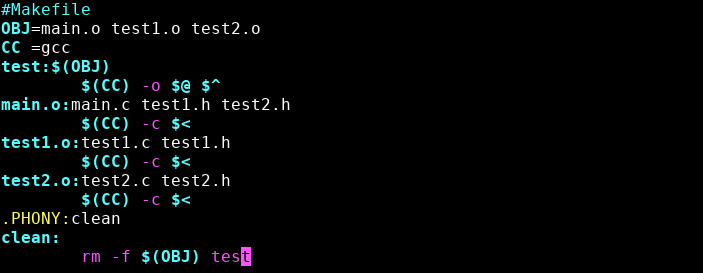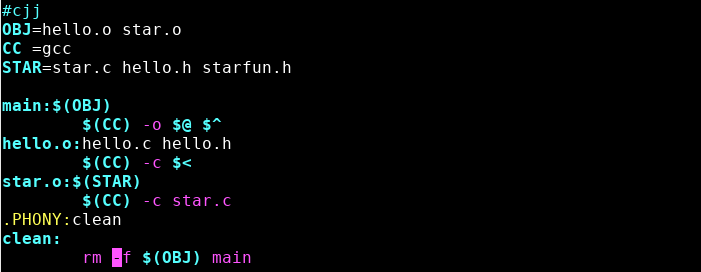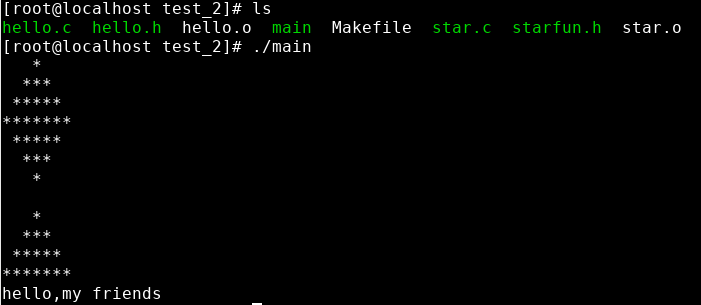实例一
1、分析源文件代码依赖关系

mian.c
#include "test1.h" #include "test2.h" #include <stdio.h> int main() { test1_func("hello test1!"); test2_func("hello test2!"); return 0; }
这里可以看出 main.o 文件的生成需要 main.c , test1.h , test2.h
test1.h
#ifndef _TEST_1_H #define _TEST_1_H void test1_func(char *str); #endif
test1.h 里面有 test1.c 里面函数的声明
test2.h
fndef _TEST_2_H #define _TEST_2_H void test2_func(char *str); #endif
test2.h 里面有 test2.c 里面函数的声明
test1.c
#include "test1.h" #include <stdio.h> void test1_func(char *str) { printf("This is test1 : %s ",str); }
生成 test1.o 文件,需要 test1.c , test1.h
test2.c
#include "test2.h" #include <stdio.h> void test2_func(char *str) { printf("This is test2 : %s",str); }
生成 test2.o 文件,需要 test2.c , test2.h
2、直接编写Makefile文件
[root@localhost MakefileExample]# vim Makefile
#Makefile main:main.o test1.o test2.o gcc -o main main.o test1.o test2.o main.o:main.c test1.h test2.h gcc -c main.c test1.o:test1.c test1.h gcc -c test1.c test2.o:test2.c test2.h gcc -c test2.c .PHONY:clean clean: rm -f *.o main

make 编译

清除生成的 .o 文件

3、运用变量编写Makefile文件
#Makefile OBJ=main.o test1.o test2.o CC =gcc test:$(OBJ) $(CC) -o $@ $^ main.o:main.c test1.h test2.h $(CC) -c $< test1.o:test1.c test1.h $(CC) -c $< test2.o:test2.c test2.h $(CC) -c $< .PHONY:clean clean: rm -f $(OBJ) test

make编译

实例二
1、分析源文件代码依赖关系

hello.c
void showhello() {
hello();
}
生成 hello.o 文件需要依赖 hello.c , hello.h
hello.h
/*hello.h*/ #ifndef HELLO_H #define HELLO_H void hello() { star1(); printf("hello,my friends "); } #endif
hello.h 里面有 star() 函数的函数体
star.c
#include "starfun.h" #include "hello.h" #include <stdio.h> int main() { star1(); star2(); showhello(); return 0; }
生成 star.o 文件,需要依赖 star.c , hello.h , starfun.h 文件
starfun.h
/*****starfun.h*****/ #ifndef STARFUN_H #define STARFUN_H #define NUM 4 #define NUMBER 3 int star1() { int i,j,k; for(k=1;k<=NUM;++k) { for(i=1;i<=(NUM-k);++i) printf(" "); for(j=1;j<=(2*k-1);++j) printf("*"); printf(" "); } return 0; } int star2() { int i,j,k; for(k=NUMBER;k>=0;--k) { for(i=1;i<=(NUMBER-k+1);++i) printf(" "); for(j=1;j<=(2*k-1);++j) printf("*"); printf(" "); } return 0; } #endif
2、直接编写Makefile文件
[root@localhost test_2]# vim Makefile
#cjj main:hello.o star.o gcc -o main hello.o star.o hello.o:hello.c hello.h gcc -c hello.c star.o:star.c hello.h starfun.h gcc -c star.c .PHONY:clean clean: rm -f *.o main

make 编译(会出现警告,不影响运行)

运行生成的文件
[root@localhost test_2]# ./main

删除 .o 文件和 main 文件

3、运用变量编写Makefile文件
#cjj OBJ=hello.o star.o CC =gcc STAR=star.c hello.h starfun.h main:$(OBJ) $(CC) -o $@ $^ hello.o:hello.c hello.h $(CC) -c $< star.o:$(STAR) $(CC) -c star.c .PHONY:clean clean: rm -f $(OBJ) main

编译并运行
